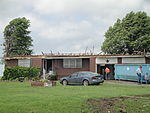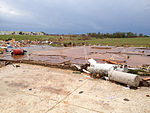The Enhanced Fujita scale is a tornado category scale used to measure tornadoes in the United States and Canada, and some other countries by how bad their damage is. It is a replacement of the old Fujita scale that was made in 1971. The National Weather Service started using it on February 1, 2007 and Canada started in April 2013. More countries have used it since then. The weakest tornadoes on this scale are rated EF0, and the strongest ones are rated EF5. Tornadoes with the EF5 label represent winds faster than 200 miles an hour. No tornadoes in the United States that happened before February 1, 2007 will have their ratings changed to the new scale.
| Scale | Wind speed (Estimated)[1] |
Example of damage | ||
| mph | km/h | |||
| EFU | Unknown | Unknown | No damage
Short for "EF-Unknown." The tornado doesn't hit anything, so there is no damage to tell how strong it is, or nobody can get to the damage to rate it. |
N/A |
| EF0 | 65–85 | 104–137 | Small damage
Well-built structures are typically unscathed, sometimes with broken windows and minor damage to roofs and chimneys. Billboards and large signs can be knocked down. Trees may have large branches broken off and can be uprooted if they have shallow roots. |

|
| EF1 | 86–110 | 138–177 | Medium damage
Damage to mobile homes and other temporary structures becomes significant. Cars and other vehicles can be pushed off the road or flipped. Permanent structures can suffer major damage to their roofs. |

|
| EF2 | 111–135 | 178–217 | Fairly bad damage
Well-built structures can suffer serious damage, including roof loss. Exterior walls at poorly built structures may collapse. Mobile homes are totally destroyed. Vehicles can be lifted off the ground, and lighter objects can become small missiles, causing damage outside of the tornado's main path. Wooded areas have a large percentage of their trees snapped or uprooted. |

|
| EF3 | 136–165 | 218–266 | Bad damage
Well-built structures lose all outer and some inner walls. Trains are overturned. Unanchored homes are swept away, and homes with poor anchoring may collapse entirely. Small vehicles and similarly sized objects are lifted off the ground and tossed as projectiles. Wooded areas suffer almost total loss of vegetation and some tree debarking may occur. |

|
| EF4 | 166–200 | 267–322 | Very bad damage
Well-built homes are reduced to a short pile of medium-sized debris on the foundation. Homes with poor or no anchoring are swept completely away. Large heavy vehicles, including airplanes, trains, and large trucks, can be pushed over, flipped repeatedly, or picked up and thrown. Large healthy trees are entirely debarked and snapped off close to the ground or uprooted altogether and become flying projectiles. Passenger cars and similarly sized objects can be picked up and flung for considerable distances. |

|
| EF5 | >200 | >322 | TOTAL DESTRUCTION
Well-built, well-anchored homes go off their foundations and into the air before obliteration. The wreckage is flung for miles, sweeping the foundation clean. Large steel-reinforced structures such as schools are completely leveled. Tornadoes of this intensity tend to shred and scour low-lying grass and vegetation from the ground. Very little recognizable structural debris is generated with most materials reduced to a coarse mix of small, granular particles and dispersed evenly across the tornado's damage path. Large, multiple-ton steel frame vehicles and farm equipment are often mangled beyond recognition and tossed miles away or reduced entirely to unrecognizable component parts. Trains and train cars can be flung 1 mile. |

|
References
[change | change source]- ↑ "Enhanced F Scale for Tornado Damage". Storm Prediction Center. Retrieved 2009-06-21.